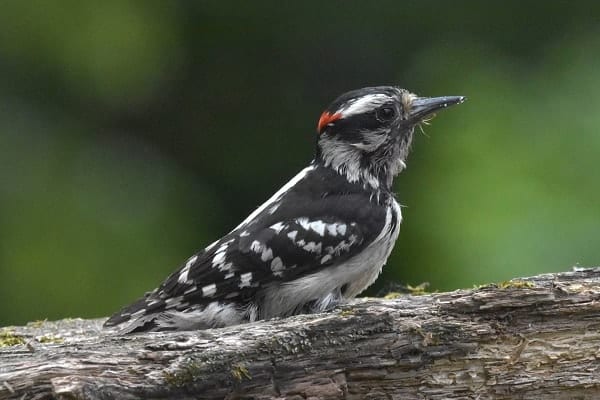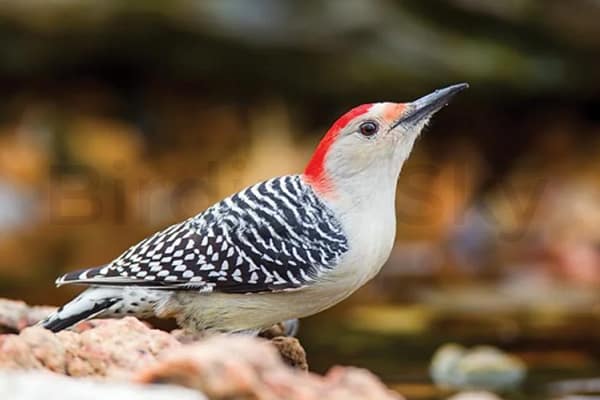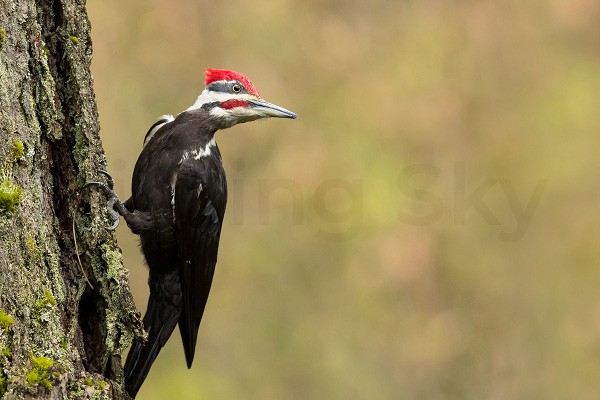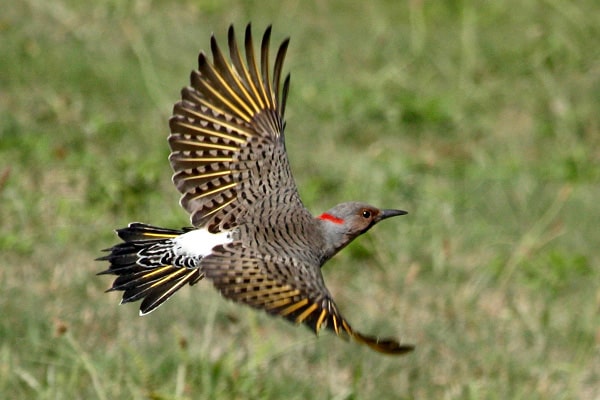Woodpeckers in Michigan are amazing birds that enrich the state’s ecosystem. In this guide, you will learn about the eight different species that live here. You will see beautiful pictures and detailed descriptions of each one. I researched this topic to help you recognize and admire these wonderful woodpeckers. Whether you love birds or nature in general, you will enjoy this guide.
Types of Woodpeckers Found in Michigan
Michigan’s woodlands and forests are bustling with life, including eight distinct woodpecker species. Each one possesses its unique traits, habits, and plumage. In this section, we’ll give you a bird’s-eye view of these fascinating woodpeckers before delving into individual profiles.
1. Downy Woodpecker

Description:
- Size: 5.5 inches
- Plumage: Black wings with white spots, white undersides
- Distinctive Feature: Small size and prominent white back
- Call: Sharp, high-pitched “peek” or “pik” sound
The Downy Woodpecker is Michigan’s miniature drumming virtuoso. Though small in size, these birds make up for it with their energetic and rhythmic tapping on tree trunks, a delightful sound to accompany your woodland stroll.
Habitat and Behavior:
- Common in woodlands, gardens, and parks
- Frequent feeder visitors
- Agile and adept at climbing tree trunks and branches
Fun Fact: Downy Woodpeckers can excavate tree cavities for nesting, which later serve as homes for various other cavity-nesting species.
2. Hairy Woodpecker

Description:
- Size: Slightly larger than the Downy Woodpecker
- Plumage: Black wings with white spots, white undersides
- Distinctive Feature: Larger size and longer bill
- Call: Resembles a sharp, high-pitched “peek” sound
The Hairy Woodpecker is often mistaken for the Downy due to their similar appearance. However, their subtle differences set them apart.
Habitat and Behavior:
- Share similar habitats with Downy Woodpeckers
- Prefer larger trees and deeper woods
- Skilled foragers for insects and tree sap
Fun Fact: Hairy Woodpeckers are known to create tree holes that benefit other cavity-nesting birds, making them vital to the forest ecosystem.
Related: Woodpeckers in Alabama
3. Red-Bellied Woodpecker

Description:
- Size: 9 inches
- Plumage: Red cap on the head, black-and-white striped back, and pale red belly
- Distinctive Feature: Prominent red cap
- Call: A rolling “query” or “churr” sound
Despite its name, the Red-Bellied Woodpecker’s belly is not its most striking feature. It’s the vibrant red cap that truly makes this species stand out.
Habitat and Behavior:
- Prefers mature forests, wetlands, and suburban areas
- Excellent at wedging food into tree crevices
- Highly vocal and communicative
Fun Fact: The name “red-bellied” is misleading, as these woodpeckers primarily store food in crevices or tree bark, not in their belly.
Must Read: Hummingbirds in Michigan
4. Red-Headed Woodpecker

Description:
- Size: 7.5 inches
- Plumage: White belly, black wings with large white patches, and a distinctive all-red head
- Distinctive Feature: Solid redhead
- Call: Varied and melodious calls
Red-headed woodpeckers are true showstoppers in Michigan’s forests, thanks to their fiery crimson crowns.
Habitat and Behavior:
- Prefer open woodlands, parks, and wetlands
- Known for their spectacular aerial displays
- Expert at catching insects in mid-air
Fun Fact: Red-headed woodpeckers are known for their habit of storing food on branches, fences, and even utility poles. They protect these caches aggressively.
Explore More: Woodpeckers in North Carolina
5. Pileated Woodpeckers in Michigan

Description:
- Size: 16-19 inches
- Plumage: Black with striking white stripes on the face and neck
- Distinctive Feature: Large size and prominent red crest
- Call: Resounding “kuk-kuk-kuk” or “wick-wick-wick” calls
The Pileated Woodpecker is Michigan’s answer to the iconic Woody Woodpecker, thanks to its distinctive appearance and boisterous calls.
Habitat and Behavior:
- Thrive in mature, undisturbed forests
- Territorial and solitary in nature
- Exceptionally skilled at excavating large tree holes
Fun Fact: These woodpeckers play an essential role in the forest ecosystem by creating cavities that provide homes for various other wildlife.
6. Northern Flicker

Description:
- Size: 12 inches
- Plumage: Brownish-gray with a black crescent on the chest, and prominent white rump patches
- Distinctive Feature: Yellow undersides and rump
- Call: Distinctive “wick-a-wick-a-wick” or “flicker” call
Northern Flickers may not fit the traditional woodpecker mold, but they’re a fascinating addition to Michigan’s avian population.
Habitat and Behavior:
- Prefer open woodlands, grasslands, and urban areas
- Often forage on the ground for ants and beetles
- Migrate during the winter
Fun Fact: Northern Flickers are unique among woodpeckers because they feed primarily on the ground, making them a bit of an oddity in the woodpecker family.
Must Read Out: Woodpecker Spiritual Meaning
7. Yellow-Bellied Sapsucker

Description:
- Size: 7.5 inches
- Plumage: Black and white, with a distinctive red forehead and throat
- Distinctive Feature: Yellowish undersides
- Call: Soft, cat-like mewing sounds
The Yellow-Bellied Sapsucker is not only a skilled tree tapper but also a connoisseur of tree sap.
Habitat and Behavior:
- Common in deciduous forests, orchards, and wetlands
- Drill holes in trees to feed on sap and insects
- Create unique, evenly spaced rows of holes called “sap wells”
Fun Fact: Yellow-bellied Sapsuckers are known to revisit their sapwells to feed repeatedly, creating intricate patterns on tree bark.
8. Black-backed woodpecker

Description:
- Size: 9 inches
- Plumage: Black back, white undersides, and a black cap on the head
- Distinctive Feature: All-black back
- Call: Soft, purring “churr” or “tchur-tchur” sounds
The Black-Backed Woodpecker has adapted to a specific niche in Michigan’s ecosystem, thriving in the aftermath of forest fires.
Habitat and Behavior:
- Prefer burned coniferous forests and recently disturbed areas
- Specialized in feeding on wood-boring beetles
- Nest in burned tree trunks
Fun Fact: Black-backed woodpeckers are often referred to as “fire birds” due to their association with post-fire environments.
FAQ’s About Woodpeckers in Michigan:
Q1: What is the most common woodpecker in Michigan?
The Downy Woodpecker (Picoides pubescens) is the most common woodpecker species in Michigan. With its small size, distinctive black-and-white plumage, and frequent visits to bird feeders, it’s a familiar sight in both urban and woodland settings.
Q2: What kind of woodpeckers do we have in Michigan?
Michigan is home to eight woodpecker species:
- Downy Woodpecker
- Hairy Woodpecker
- Red-Bellied Woodpecker
- Red-Headed Woodpecker
- Pileated Woodpecker
- Northern Flicker
- Yellow-Bellied Sapsucker
- Black-Backed Woodpecker
Each of these woodpeckers has unique features and habits that set them apart.
Q3: What does a Michigan woodpecker look like?
Michigan’s woodpeckers come in various sizes and colors, but they often share common features such as distinctive black-and-white plumage patterns. Some have striking red or yellow markings, while others, like the Pileated Woodpecker, boast prominent crests. Their appearances can range from small and delicate to large and majestic.
Q4: How big is a Michigan woodpecker?
Michigan’s woodpeckers vary in size, with the smallest being the Downy Woodpecker at around 5.5 inches and the largest being the Pileated Woodpecker, which can reach 16-19 inches. The other species fall within this size range, making Michigan’s woodpeckers diverse in their physical characteristics.
Q5: Which is the most common woodpecker?
The Downy Woodpecker is the most common woodpecker in Michigan. Its small size, white back, and frequent visits to backyards and bird feeders make it easily recognizable and frequently observed by bird enthusiasts.
